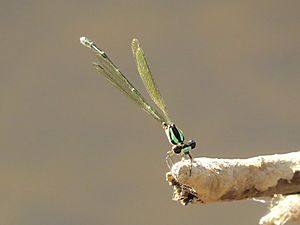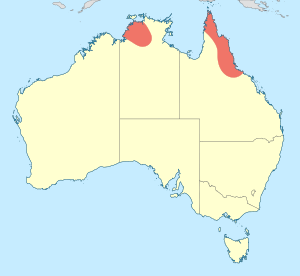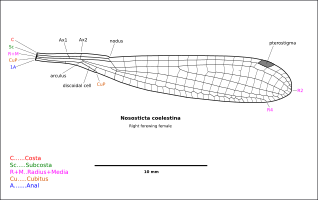Green-blue threadtail facts for kids
Quick facts for kids Green-blue threadtail |
|
|---|---|
 |
|
| Green-blue threadtail (male) | |
 |
|
| Green-blue threadtail (female) | |
| Conservation status | |
| Scientific classification | |
 |
The green-blue threadtail (scientific name: Nososticta coelestina) is a beautiful damselfly found in Australia. It belongs to a family of damselflies called Platycnemididae. These amazing insects usually live close to rivers and streams.
Contents
About the Green-blue Threadtail
The green-blue threadtail is a type of damselfly. Damselflies are insects that look a lot like dragonflies. However, damselflies are usually smaller and more slender. When they rest, most damselflies hold their wings together over their back. Dragonflies, on the other hand, often hold their wings out flat.
What Does It Look Like?
This damselfly is a medium-sized insect. It grows to be about 35 to 40 millimeters long. That's about the length of two paperclips! Its wingspan is usually similar to its body length.
The male and female green-blue threadtails look a bit different.
- Males: Their main body part, called the thorax, is black. It has bright greenish-blue markings that really stand out.
- Females: Their thorax is a pale brown color.
Both males and females have a dark abdomen, which is the long part of their body. This dark part has thin, pale bands between its segments. Their wings often have a yellow or lemon tint, which adds to their unique look.
Where Does It Live?
The green-blue threadtail is found only in Australia. It prefers to live in places with lots of water, like near rivers and streams. You can find them in the northern and eastern parts of the continent. Their range stretches from the very top of the Northern Territory all the way down to central Queensland. They need suitable habitats with clean water to thrive.
Is It Endangered?
Scientists keep track of how many animals are left in the wild. This helps them know if a species is in danger. The green-blue threadtail has been studied by the IUCN Red List. This is a global list that checks the conservation status of different species.
Good news! The green-blue threadtail is listed as a species of "Least Concern." This means that, for now, there are plenty of them in the wild. They are not considered to be in danger of disappearing.
Gallery




